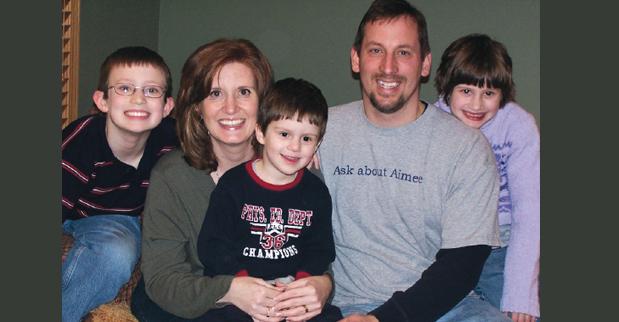
Talking to Your Kids About ALS

Aimee Chamernik, 37, of Grayslake, Ill., and (from left) sons Nick, 9; Zachary, 3; husband Jim and daughter Emily, 7. Chamernik writes about talking with her children about ALS.
As we huddle on the couch, munching popcorn and engrossed in our movie, the kids and I are startled by a sharp knock at the door. Before I can shift forward to start the painstaking process of standing up, our neighbors burst into our house.
“Are you OK?!” Beth asks breathlessly.
“Yes, we’re fine,” I answer sheepishly, as it dawns on me that I never called my husband back after Nick left a message for him telling him I’d fallen. I’d been so preoccupied with reassuring Nick (9), Emily (7) and Zachary (3) that I was OK — and responding to Zachary’s persistent demands for popcorn — I’d forgotten to follow up on Nick’s frantic call. “I’m so sorry!”
“Oh, we’re just glad you’re OK!” they say in unison. “Jim called because your phone is off the hook, and he was worried.”
I dig the phone out of the couch cushions and click “end.”
“Oops! No, we’re fine. I’ll call Jim right away.”
The kids, at first too stunned to speak, start spouting a hundred questions at once.
“What are you doing here?” “Did you think our mom was hurt?” “How did you know she fell?”
After a few moments of small talk — apologies and profuse thanks on my side, gracious reassurances on theirs — they pull the door shut behind them.
“Well,” I say, turning to the kids, “I feel terrible that we made everyone worry, but that was kind of good practice for an emergency.”
“Like a tornado drill at school,” Emily nods.
“At least we know we can count on our neighbors for help!” Nick pipes up.
And those words make this embarrassing incident worthwhile. I’m glad he feels reassured.
Since ALS has invaded our lives, the toughest challenge has been embroiling our innocent children in this losing battle. While we were tempted to try to shield them from ALS for as long as possible, we’ve ended up taking the opposite approach.
After two-plus years, do we have all the answers? Hardly. But we‘re finding that a straightforward approach helps to draw our family closer together through this experience.
Here are some of the tenets we try to live by:
Be honest
We talk honestly about ALS with our kids, answering questions in an age-appropriate way. We’ve promised that we will always tell them the truth, and if we don’t know an answer we will try to find one.
Our conversations have ranged from matter-of-fact to heart-wrenching, but the unifying characteristic is that after all of them the kids feel better. By discussing their questions or fears openly, we can help them deal with their feelings.
Don’t dwell on ALS
As my balance and coordination began to fail, we slipped into the habit of telling the kids to pick up their toys “or Mom could fall.” We quickly realized that we were wrongly shifting the focus to ALS. If ALS weren’t part of our lives, we would still teach our children to pick up their toys.
While ALS is unavoidable at times, we try to steer clear of needlessly emphasizing the disease that already commands so much attention.
Keep persevering
You know how kids have that uncanny knack for never hearing “please put your dirty clothes in the hamper” but always hearing what you’d hoped slipped past them? In the back of my mind is the knowledge that my children are watching and learning from me every moment of every day.
I try to let that knowledge guide my behavior on the days when I want to hide under the covers and never come out. Is that how I want them to remember me dealing with adversity? Or how I want them to face adversity in their lives?
No, I want to teach them to dig deep and find the inner strength to live each moment to the fullest. And I don’t hesitate to talk about that choice.
“This is one of those times when I just want to give up,” I’ll say. “But I will not let ALS win!”
Let the kids help
This one’s tough. I’m struck by how topsy-turvy our lives have become; my kids now tie my shoes instead of having me tie theirs. I struggle with becoming a burden, but they are happy to help. Whether they are fetching things I’ve dropped, carrying my purse, or shielding me in public places, they’re glad to be my arms and legs.
“When I keep people from bumping into you, I feel like your knight in shining armor!” Emily grins proudly.
Furthermore, they’re learning patience, kindness, and sensitivity to the needs of others. This isn’t how anyone would choose to instill those traits, but I can’t help but be grateful for that positive.
Take control where we can
Jim and I often lament our lack of control, with ALS constantly lurking and snatching more from our family. We can only imagine how much stronger that feeling is for the kids.
One way we can take back a measure of control is by trying to make a difference in the fight against ALS. The kids are eager to join fund-raising efforts, participate in events to raise awareness, and write or draw about their experiences with ALS.
We also establish some control by staying a few steps ahead of my disease. Whether we’re installing grab bars, removing household hazards, or enlisting neighbors to check on me, we keep the kids involved in our safety measures and plans.
When our neighbors burst in on us that night, the kids talked about it for weeks. They are comforted by the fact we have people who care about us and are ready to help out at a moment’s notice.
And while we’d rather shield the kids from ALS entirely, we all find comfort in facing it together.
Aimee Chamernik received a diagnosis of ALS in 2004.